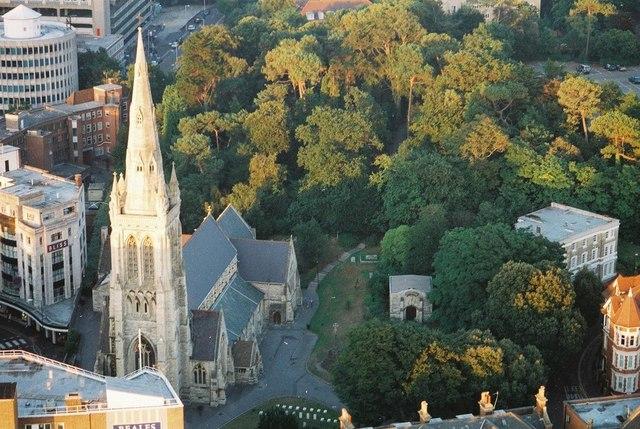Yr Eglwys Norwyaidd
Bae Caerdydd, City of Cardiff
Anaml iawn y gwelwch yng Nghymru eglwys sydd â chladin pren gwyn – ac mae gan yr Eglwys Norwyaidd stori unigryw i’w hadrodd, yn ogystal â chysylltiad ag un o hoff awduron plant y byd: Roald Dahl.

St Peter's was completed in 1879 to a design by GE Street as the founding mother church of Bournemouth.
Bournemouth, Dorset
The building incorporates work by some of the finest Gothic Revival architects and artists, including Street, George Frederick Bodley, Ninian Comper, Arthur Blomfield and Edward Burne-Jones, with stained glass and frescoes by Clayton and Bell. The chancel has been described as 'one of the richest Gothic Revival interiors in England'.
The church was built over a period of twenty-four years from 1855 at the instigation of the vicar, the Reverend Alexander Morden Bennett, to replace an earlier building. GE Street was commissioned to create a finer church to match the beauty of the town. It was constructed between 1854 and 1879 on the foundations of the 1840s predecessor.
The church, which sits opposite Beales department store in the heart of the town centre, was the founding mother church of Bournemouth. The 202foot, 62m, spire is a landmark across the town centre and beyond. It has unusual paintings, notable stained glass and alabaster.
St Peter's has many famous connections. William Ewart Gladstone, the Prime Minister, took his last communion here. The composer Sir Hubert Parry was born in the parish in 1848 and baptised in St. Peter's, and his mother Isabella is buried in the churchyard. John Keble, one of the leaders of the Oxford Movement, vicar at All Saints' Hursley in the New Forest and professor of poetry at Oxford, died in the parish in 1866. There are two stained glass windows of him in his cassock in the church.
The Shelley family vault deserves especial mention. Mary Shelley, author of Frankenstein, is interred there, along with the heart of her husband, the poet Percy Bysshe Shelley, who had died abroad. Their only surviving child, Sir Percy Florence Shelley, built a house in nearby Boscombe, believing that the balmy climate would help his sick wife and his mother. Mary Shelley had expressed a wish to be buried with her parents, Mary Wollstonecraft, the feminist philosopher, and William Godwin, one of the founders of theoretical anarchism. Wollstonecraft and Godwin had died in London and were buried in the churchyard of St Pancras Old Church. Sir Percy and his wife had them dug up and moved to Bournemouth.
Bae Caerdydd, City of Cardiff
Anaml iawn y gwelwch yng Nghymru eglwys sydd â chladin pren gwyn – ac mae gan yr Eglwys Norwyaidd stori unigryw i’w hadrodd, yn ogystal â chysylltiad ag un o hoff awduron plant y byd: Roald Dahl.
Marshfield, Gwent
Mae Eglwys St Mair, Maerun, yn eglwys brydferth sy’n dyddio nôl i’r ddeuddegfed ganrif. Yn nythu’n glud yn y llain las rhwng Caerdydd a Chasnewydd, mae bellach yn adnabyddus am fod yn lleoliad ar gyfer un o episodau Dr Who!
Grangetown, City of Cardiff
Mae gwaith y pensaer John Coates Carter yn gyfrinach sydd wedi ei chadw’n ddiogel. Mae ei adeiladau’n ymgorffori y Mudiad Celfyddyd a Chrefft ar ddechrau’r ugeinfed ganrif – a dywedir bod eglwys St Paul ymhlith y gorau o’i eglwysi cynnar sydd wedi goroesi.